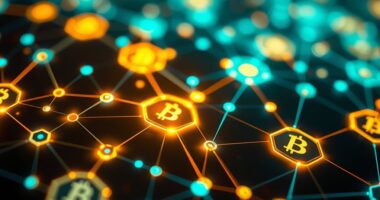By tokenizing real-world assets like real estate, commodities, and invoices, you can bring traditional finance onto the blockchain and access new investment opportunities within DeFi. This process increases transparency, reduces costs, and makes previously illiquid assets tradable. While regulatory and technical challenges exist, ongoing efforts aim to create secure, compliant environments. Explore further to discover how industry collaborations are revealing the full potential of asset tokenization and transforming finance as we understand it.
Key Takeaways
- Asset tokenization converts real-world assets into blockchain tokens, enabling their integration into DeFi platforms.
- Standardization and regulatory compliance are essential to securely bring traditional finance assets on-chain.
- Challenges include legal, logistical, and valuation complexities, especially in real estate and commodities.
- Industry efforts focus on developing protocols, standards, and collaborations to address fragmentation and regulatory hurdles.
- Successful on-chain integration of real-world assets enhances transparency, liquidity, and access to traditional financial markets.

Have you ever wondered how traditional assets like real estate, commodities, or invoices are transforming into digital investments? The answer lies in the process of tokenization, which converts these physical assets into blockchain-based tokens. This innovation opens up new opportunities for investors to access previously illiquid markets, increase transparency, and reduce transaction costs. However, despite its potential, tokenization faces significant challenges, especially regarding Tokenization Challenges and Regulatory Implications. These hurdles can slow down adoption and complicate the path toward seamless integration of real-world assets into DeFi.
Tokenization Challenges primarily stem from the complexity of accurately representing physical assets on-chain. For instance, real estate involves a multitude of legal and logistical considerations—title deeds, property rights, and valuation—that must be carefully encoded. Guaranteeing the integrity of these digital representations demands robust verification processes, which are not yet standardized across the industry. Furthermore, assets like commodities or invoices require reliable data feeds and oracles to reflect their true value, creating potential points of failure or manipulation. This complexity makes it difficult to develop universally accepted standards, leading to fragmentation within the market. Additionally, issues related to custody, ownership transfer, and enforcement of rights need to be meticulously managed to prevent disputes and guarantee legal enforceability.
Regulatory implications present another major obstacle. Different jurisdictions have varying laws regarding asset ownership, securities, and financial transactions. When assets are tokenized and traded on decentralized platforms, regulators face the challenge of applying existing laws to these new digital formats. You may find that some jurisdictions classify tokenized assets as securities, requiring compliance with strict registration and reporting standards, while others may lack clear guidance altogether. This regulatory uncertainty can deter institutional investors from participating, fearing legal repercussions or compliance risks. Furthermore, anti-money laundering (AML) and know-your-customer (KYC) regulations become more complex to enforce in a decentralized environment, raising concerns about illicit activities. Exploring these regulatory landscapes demands significant effort from issuers, platforms, and investors alike, often requiring legal expertise and collaboration with regulators.
Despite these challenges, progress continues as industry players and regulators explore solutions. Standardizing tokenization protocols and fostering dialogue between regulators and innovators are vital steps. As you consider investing in real-world assets via DeFi, understanding these hurdles helps you appreciate the ongoing efforts to establish a secure, compliant, and efficient ecosystem. Overcoming tokenization challenges and regulatory implications will be key to opening the full potential of bringing traditional assets on-chain, ultimately transforming how you access and manage investments in the digital age.
Frequently Asked Questions
How Are Real-World Assets Valued On-Chain?
You determine real-world assets’ value on-chain through digital valuation methods that analyze market data, appraisals, and comparable assets. Collateral frameworks help secure these assets, ensuring their value is accurately reflected in the system. You can use oracles to fetch real-time data, enabling transparent and reliable assessments. This process allows you to seamlessly integrate traditional assets into DeFi, supporting lending, trading, and other financial activities confidently.
What Legal Protections Exist for Defi Real-World Asset Investors?
You benefit from legal compliance and investor protections when investing in DeFi real-world assets. Regulations require platforms to follow specific rules, safeguarding your rights and ensuring transparency. Many protocols implement features like dispute resolution, collateral management, and insurance options to further protect your investments. While risks remain, these legal frameworks and protections aim to create a safer environment, giving you more confidence when engaging with real-world assets on DeFi platforms.
How Is Asset Liquidity Managed in Defi Platforms?
You actively manage asset liquidity in DeFi platforms by utilizing collateral management and liquidity pools. You provide assets as collateral to back loans or trades, ensuring stability and trust. Liquidity pools enable you to deposit funds, which are pooled together to facilitate trading and lending activities. This system maintains continuous asset availability, promotes smooth transactions, and helps prevent liquidity shortages, keeping the platform efficient and responsive to user demands.
What Are the Risks of Tokenizing Physical Assets?
Imagine holding a fragile glass sculpture, unsure if it’s truly yours or just a copy. Tokenizing physical assets carries custody challenges—you might lose control or face theft—and fraud risks, like fake claims or misrepresented ownership. You risk the asset’s authenticity and security, and if the custodian mishandles or manipulates the tokens, your investment could vanish. Trusting the process without proper safeguards can leave you exposed to significant financial harm.
How Do Regulatory Frameworks Impact Defi Real-World Assets?
Regulatory frameworks profoundly impact DeFi real-world assets by creating compliance challenges and highlighting jurisdictional differences. You’ll need to navigate varying rules across regions, which can slow down adoption and increase legal risks. Staying compliant requires understanding local laws, implementing proper KYC/AML procedures, and adjusting your strategies accordingly. These regulatory complexities can limit liquidity, restrict asset types, and influence how seamlessly you can integrate traditional assets into DeFi platforms.
Conclusion
As you navigate the DeFi landscape, imagine it as a vast ocean where real-world assets act as sturdy ships anchoring your journey. By bringing traditional finance on-chain, you’re building bridges over turbulent waters, making financial seas safer and more accessible. Embrace this wave of innovation, and you’ll find yourself sailing toward a future where digital and physical assets move in harmony, transforming the financial horizon into a limitless horizon of opportunity.








